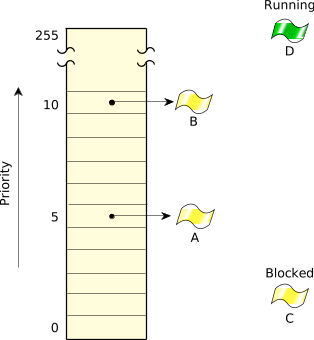In the FIFO scheduling policy, a thread is allowed to consume CPU for as long as it wants. This means that if that thread is doing a very long mathematical calculation, and no other thread of a higher priority is ready, that thread could potentially run forever. What about threads of the same priority? They're locked out as well. (It should be obvious that threads of a lower priority are locked out too.)
If the running thread quits or voluntarily gives up the CPU, then the kernel looks for other threads at the same priority that are capable of using the CPU. If there are no such threads, then the kernel looks for lower-priority threads capable of using the CPU. Note that the term “voluntarily gives up the CPU” can mean one of two things. If the thread goes to sleep, or blocks on a semaphore, etc., then yes, a lower-priority thread could run (as described above). But there's also a “special” call, sched_yield() (based on the kernel call SchedYield()), which gives up CPU only to another thread of the same priority—a lower-priority thread would never be given a chance to run if a higher-priority was ready to run. If a thread does in fact call sched_yield(), and no other thread at the same priority is ready to run, the original thread continues running. Effectively, sched_yield() is used to give another thread of the same priority a crack at the CPU.
In the diagram below, we see three threads operating in two different processes:
 Figure 1. Three threads in two different processes.
Figure 1. Three threads in two different processes.If we assume that threads “A” and “B” are READY, and that thread “C” is blocked (perhaps waiting for a mutex), and that thread “D” (not shown) is currently executing, then this is what a portion of the READY queue that the microkernel maintains will look like:
 Figure 2. Two threads on the READY queue, one blocked, one running.
Figure 2. Two threads on the READY queue, one blocked, one running.This shows the kernel's internal READY queue, which the kernel uses to decide what to schedule next. Note that thread “C” is not on the READY queue, because it's blocked, and thread “D” isn't on the READY queue either because it's running.